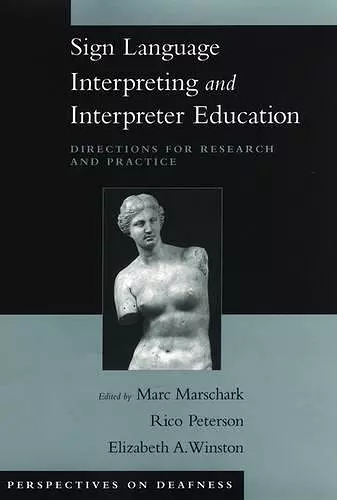Sign Language Interpreting and Interpreter Education
Directions for Research and Practice
Marc Marschark editor Elizabeth A Winston editor Rico Peterson editor
Format:Hardback
Publisher:Oxford University Press Inc
Published:19th May '05
Currently unavailable, and unfortunately no date known when it will be back

This book offers a comprehensive overview of interpreting and interpreter education, evaluating practices through research. It serves as a valuable reference for training programs and courses in related fields.
Sign Language Interpreting and Interpreter Education offers a comprehensive overview of the interpreting field and the education of interpreters, emphasizing the importance of evidence-based practices. This book serves as both a reference and a textbook for interpreter training programs, as well as for courses related to bilingual education, psycholinguistics, translation, and cross-linguistic studies. With over 1.46 million individuals in the U.S. classified as deaf and an additional 21 million experiencing other hearing impairments, the demand for effective sign language and voice interpreting is significant. However, the current supply of interpreters falls short, leading to variable quality and a general lack of understanding regarding the factors that contribute to successful interpreting.
The book highlights the pressing need for quality interpreting services, particularly in educational settings where more than 75% of deaf students are now integrated into mainstream schools. Unfortunately, many of these environments lack the necessary support, as teachers and peers often cannot communicate using sign language. This situation has resulted in a reported 70% dissatisfaction rate among deaf individuals regarding interpreting quality, as noted by the National Association of the Deaf (NAD). Recent legislation has further underscored the necessity for improved access to educational and public services for those with hearing disabilities.
By synthesizing existing research and addressing gaps in knowledge, Sign Language Interpreting and Interpreter Education stands out as the first comprehensive resource in the field. It evaluates current educational models within interpreter training programs, providing insights into what is known, what remains unknown, and what should be prioritized for future research. This book is an essential tool for educators, interpreters, and students alike, promoting a deeper understanding of the interpreting profession and its educational foundations.
ISBN: 9780195176940
Dimensions: 165mm x 243mm x 21mm
Weight: 721g
328 pages